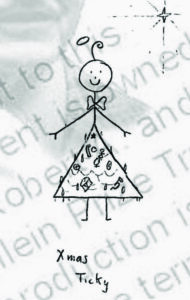
December 1947 was a tough time for Robert and Ginny. Robert’s divorce from Leslyn was not final, so the only way they could be together was on the road. He invested some of his dwindling cash in a tiny house trailer he nicknamed the Gopher Hole, which he joked was formerly a piano box! They were staying just outside Fort Worth, TX. Robert was working on Space Cadet at the time, but wasn’t receiving any royalties and was in dire straits for money. The following passage is directly from the biography:
“Christmas that year was very memorable. Their trailer lot had a pine sapling on it, about four feet high. Ginny made strings of popcorn and cranberries and decorated the tree with bits of bread and bacon fat, to attract birds. It also attracted the neighborhood’s local mutt. He ate the bread bits off the tree, so Ginny give him larger bits of bread. Robert laughed and called him their “Broad-gauged Texas Bread-Wolfer.” They had acquired a family.
It got very cold. There was snow on the ground and no heat at all. Robert bundled up with every article of clothing he could get on, in layers, but his fingers would go numb, making it almost impossible to type. One morning, Ginny slipped on a patch of ice on the stair, coming out of the trailer with a glass pitcher in each hand. She landed on her tail in the ice and burst into tears, not because of the pain, but out of fear she had broken the pitchers, which they could not afford to replace. They were intact—not even nicked—and the pitchers didn’t matter in any case, but that kind of devotion was touching and irreplaceable.
Presents were one of the few things for which Robert would let Ginny touch the savings she had put away from her work in Los Angeles. A wildly extravagant gift might well show how full and overflowing her heart was—but, of course, it could also be an implied criticism. Robert liked long, loose dressing gowns that reached all the way down to the ankles—a Japanese style it was impossible to find in stores. She ordered Springmaid cotton fabric and a pattern, and sewed the robe herself, in yellow, with Springmaid girls all over it—and another in red cotton trimmed with the Springmaid fabric. She also made a little doll—a caricature of herself—out of a pair of the silk gloves she had worn as a little girl, with cardboard body in the shape of a Ticky picture, with cotton puffs for fuzzy slippers and a red, white, and blue ribbon. After he went to sleep on Christmas Eve, she arranged it in his Christmas stocking, peeking out over the top.
Heinlein had done a little sneaking around himself. On Christmas Eve, he found an excuse to go out and found a bottle of perfume for her that he could afford—$2.00 in a drugstore.
In the morning, Heinlein was overwhelmed by the robes—and by the Ticky doll, even more than the robes. After breakfast, he propped up the Ticky doll by his working setup (and kept it on his desk for the rest of his life). It inspired him that day; he wrote most of a chapter. Ginny was sentimental over her perfume, too, knowing that it was a widow’s mite. She kept the bottle for the rest of her life.”
– “Robert A. Heinlein: In Dialogue with His Century: Volume 1: Learning Curve 1907-1948″ by William H. Patterson Jr.”
Ticky sketch by Robert A. Heinlein
Photo courtesy of The Heinlein Prize Trust (and thanks to John Seltzer)




